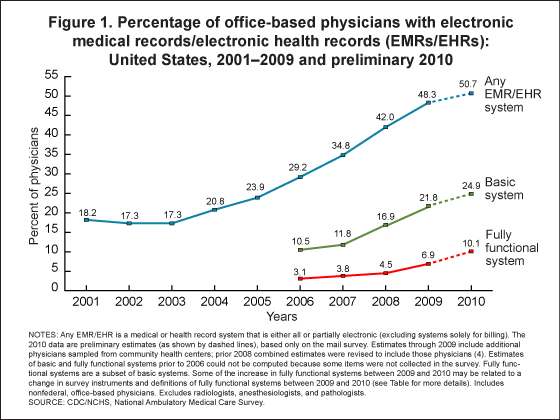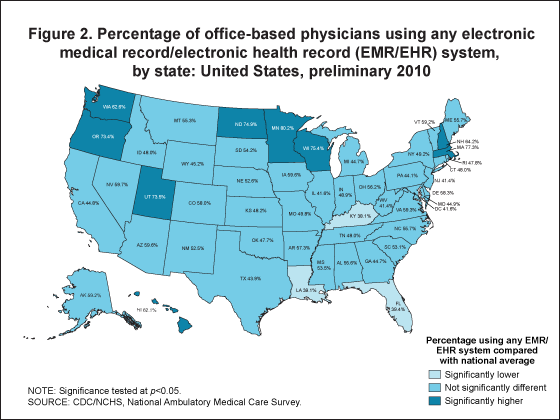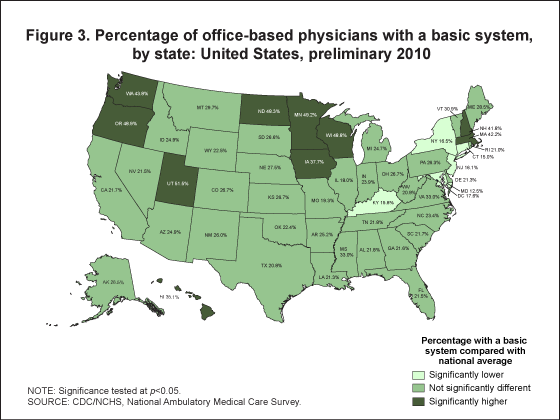Electronic Medical Record/Electronic Health Record Systems of Office-based Physicians: United States, 2009 and Preliminary 2010 State Estimates
by Chun-Ju Hsiao, Ph.D.; Esther Hing, M.P.H.; Thomas C. Socey; and Bill Cai, M.A.Sci., Division of Health Care Statistics
PDF Version (212 KB)
Policymakers’ interest in the progress of health information technology adoption by health care providers has increased greatly since The American Recovery and Reinvestment Act was signed into law in 2009. A portion of the bill, the Health Information Technology for Economic and Clinical Health Act, authorized incentive payments through Medicare and Medicaid to providers that use certified electronic health records to achieve specified improvements in care delivery (1). The U.S. Department of Health and Human Services finalized the meaningful use criteria for the first 2 years of the three-stage incentive program in mid-2010 (2).
The National Ambulatory Medical Care Survey (NAMCS), conducted by the Centers for Disease Control and Prevention’s National Center for Health Statistics (NCHS), is an annual nationally representative survey of patient visits that includes office-based physicians and collects information on the adoption and use of electronic medical records/electronic health records (EMRs/EHRs). Since 2008, a supplemental mail survey on EMRs/EHRs has been conducted in addition to the core NAMCS, an in-person survey. In 2010, the mail survey sample size increased five-fold to allow for state-level estimates, and survey questions were slightly modified to ask physicians about their intentions to apply for meaningful use incentive payments.
EMR/EHR systems of office-based physicians
The estimate of all or partial EMR/EHR systems was obtained from the question, “Does this practice use electronic medical records or electronic health records (not including billing records)?” In addition to the question asking about all or partial EMR/EHR systems, physicians also reported the computerized functionalities of their practices. EMR/EHR systems were classified as basic or fully functional (see Table ) (3).
There has been an increasing trend in EMR/EHR use among office-based physicians from 2001 through the preliminary 2010 estimates (Figure 1). Combined data from the 2009 surveys (mail survey and in-person survey) showed that 48.3% of physicians reported using all or partial EMR/EHR systems in their office-based practices. About 21.8% of physicians reported having systems that met the criteria of a basic system, and about 6.9% reported having systems that met the criteria of a fully functional system, a subset of a basic system. Preliminary 2010 estimates from the mail survey showed that 50.7% of physicians reported using all or partial EMR/EHR systems, similar to the 2009 estimate. About 24.9% reported having systems that met the criteria of a basic system, and 10.1% reported having systems that met the criteria of a fully functional system, a subset of a basic system. Between 2009 and 2010, the percentage of physicians reporting having systems that met the criteria of a basic or a fully functional system increased by 14.2% and 46.4%, respectively. Due to questionnaire modifications in 2010, survey items used to define basic and fully functional systems are slightly different from 2009 (see Table ).
Preliminary 2010 estimates from the mail survey showed that the percentage of physicians using all or partial EMR/EHR systems by state ranged from 38.1% to 80.2% (Figure 2). The percentage of physicians having systems that met the criteria of a basic system by state ranged from 12.5% to 51.5% (Figure 3). Excluding 27 states with unreliable estimates, the percentage of physicians having systems that met the criteria of a fully functional system across the United States ranged from 9.7% to 27.2% (data not shown).
Methods
NAMCS includes a national probability sample survey of nonfederal office-based physicians. The target universe of NAMCS physicians is physicians classified as providing direct patient care in office-based practices, including additional clinicians in community health centers. Radiologists, anesthesiologists, and pathologists are excluded. In 2008 and 2009, samples of physicians in the core in-person NAMCS and the supplemental mail survey stratified by specialty were selected from 112 geographic areas. To provide state-level estimates, the 2010 mail survey sample was selected from the 50 states and the District of Columbia.
In 2009, samples of 3,200 and 2,000 physicians were selected for the core in-person NAMCS and the supplemental mail survey, respectively. The 2009 core NAMCS covered from December 2008 through December 2009, and the 2009 mail survey March through June 2009. The final estimates of 2009 EMR/EHR use combine the core NAMCS and the mail survey. The unweighted response rate of the 2009 combined surveys was 70% (both unweighted and weighted).
From April through July 2010, NCHS surveyed a sample of 10,301 physicians with the mail survey and followed up with telephone calls to nonrespondents. The preliminary 2010 estimates reported here were based on the 2010 mail survey. The unweighted response rate was 68% (66% weighted) in 2010. A copy of the 2009 and 2010 surveys can be obtained from the NCHS website.
Statements of differences in estimates are based on statistical tests with significance at the p<0.05 level. Terms relating to differences, such as “increased” or “decreased,” indicate that the differences are statistically significant. A lack of comment regarding the difference does not mean that the difference was tested and found to be not significant.
References
- Centers for Medicare & Medicaid Services. The official website for the Medicare and Medicaid EHR Incentive Programs.
- Medicare and Medicaid EHR Incentive Program, 42 C.F.R. pts 412, 413, 422, and 495 (2010).
- Health information technology in the United States: Where we stand, 2008. Robert Wood Johnson Foundation. 2008.
- Hsiao CJ, Beatty PC, Hing E, Woodwell DA, Rechtsteiner EA, and Sisk JE. Electronic medical record/electronic health record use by office-based physicians: United States, 2008 and preliminary 2009. National Center for Health Statistics Health E-stat. December 2009.
Table. Survey items defining fully functional and basic electronic medical record systems
| Feature of electronic medical record systems | Basic system1 | Fully functional system1 |
|---|---|---|
| Patient history and demographics | √ | √ |
| Patient problem lists | √ | √ |
| Physician clinical notes | √ | √ |
| Medical history and follow-up notes2 | … | √ |
| List of medications taken by patients3 | √ | √ |
| Comprehensive list of the patient’s allergies | … | … |
| Computerized orders for prescriptions | √ | √ |
| Drug interaction or contraindication warning provided | … | √ |
| Prescription sent to pharmacy electronically | … | √ |
| Computerized orders for lab tests | … | √ |
| Test orders sent electronically | … | √ |
| Viewing lab results | √ | √ |
| Results incoporated into EMR/EHR | … | … |
| Out-of-range values highlighted | … | √ |
| Computerized orders for radiology tests3 | … | √ |
| Viewing imaging results | √ | √ |
| Electronic images returned2 | … | √ |
| Guideline-based interventions or screening tests | … | √ |
| Electronic reporting to immunization registries | … | … |
| Public health reporting | … | … |
| Notifiable diseases sent electronically | … | … |
… Category not applicable.
1 Based on definition presented in Health Information Technology in the United States: Where We Stand, 2008, Robert Wood Johnson Foundation.
2 Included in 2009, not available in 2010.
3 Included in 2010, not available in 2009.
NOTE: Survey items are from the National Ambulatory Medical Care Survey.
Figures
- Page last reviewed: November 6, 2015
- Page last updated: December 8, 2010
- Content source:


 ShareCompartir
ShareCompartir


